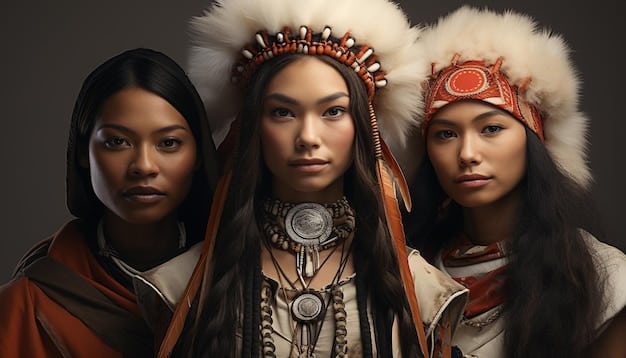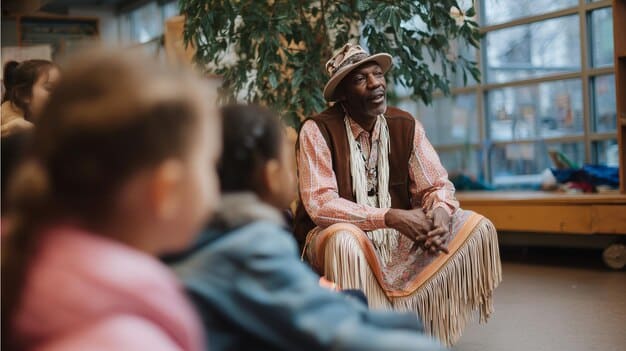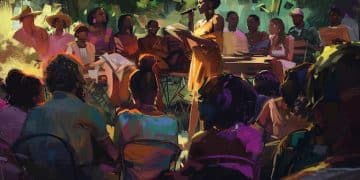Celebrating Native American Heritage: 4 Must-Attend November Events

Advertisements
November marks Native American Heritage Month, a time dedicated to honoring the rich histories, vibrant cultures, and significant contributions of Indigenous peoples, with various essential cultural events providing invaluable opportunities for education, reflection, and celebration across the United States.
November is a month of profound significance, offering a unique opportunity to delve into the enduring legacies and contemporary vibrancy of Indigenous cultures. As we approach Native American Heritage Month, exploring meaningful ways to participate in this observation becomes paramount. This guide focuses on Celebrating Native American Heritage: A Guide to 4 Essential Cultural Events in November, providing insights into gatherings that honor tradition, foster understanding, and celebrate the resilience of Native American communities.
Advertisements
Understanding Native American Heritage Month
Native American Heritage Month, observed every November, highlights the intricate histories, diverse cultures, and profound contributions of Native Americans. It’s a period set aside not only for acknowledging past struggles and triumphs but also for recognizing the ongoing vitality and resilience of Indigenous communities across the United States. This designation serves as a crucial reminder of the continuous impact Native peoples have had, and continue to have, on the fabric of American society.
The observance of this month traces its roots back to the early 20th century, with various individuals and organizations advocating for a day or week dedicated to Native peoples. Dr. Arthur C. Parker, a Seneca Indian, was instrumental in this effort, proposing the idea to the Boy Scouts of America. Over decades, these efforts culminated in President George H.W. Bush formally declaring November as National Native American Heritage Month in 1990. This proclamation solidified a commitment to educating the public about the rich heritage, unique challenges, and significant contributions of Indigenous peoples.
The Significance of November
November was chosen for its historical connections to Indigenous peoples. It often coincides with traditional harvest festivals and significant spiritual gatherings among many Native American tribes. This timing allows for a natural convergence of cultural celebration and historical reflection, reinforcing the deep, ancient ties between land, community, and tradition.
- Historical Acknowledgment: It provides a platform to address historical injustices and to promote a more accurate understanding of American history, including the pre-colonial era and the devastating impacts of colonization.
- Cultural Preservation: The month encourages the preservation and revitalization of Indigenous languages, customs, and artistic expressions, many of which were suppressed for centuries.
- Contemporary Recognition: It celebrates the achievements of contemporary Native Americans in all fields, from arts and sciences to politics and environmental advocacy, showcasing their continued influence and innovation.
Beyond official declarations, Native American Heritage Month is a grassroots movement, driven by tribal nations, cultural organizations, and individuals dedicated to promoting Indigenous narratives. It is a time for genuine engagement, for listening to Native voices, and for supporting Native-led initiatives. Understanding its roots and purpose lays the groundwork for meaningful participation in the events that define this important month.
Reflecting on this month deepens our appreciation for Indigenous American heritage. It is not merely a ceremonial observation but an active commitment to learning and engagement, recognizing the past while looking forward to a future built on respect and understanding.
Event Spotlight 1: National Native American Heritage Month Celebration (Washington, D.C.)
As the capital of the United States, Washington, D.C., becomes a central hub for Native American Heritage Month celebrations. The city hosts numerous events, often centered around the National Museum of the American Indian (NMAI), a Smithsonian institution dedicated to the life, languages, literature, history, and arts of Native Americans of the Western Hemisphere.
The NMAI typically organizes a robust calendar of events throughout November, embodying the spirit of celebration and education. These activities are designed to appeal to a broad audience, from academic scholars to families with young children, ensuring a comprehensive and accessible experience of Indigenous cultures.
What to Expect at NMAI
Visitors to the NMAI during November can anticipate a rich array of programs. These often include traditional music and dance performances, showcasing the diversity of Indigenous artistic expressions. Storytelling sessions are a highlight, offering profound insights into Native cosmologies, historical narratives, and contemporary experiences, often told by elders and cultural practitioners who carry centuries of oral tradition.
- Live Demonstrations: Artisans frequently demonstrate traditional crafts such as basket weaving, pottery making, and beadwork, providing a hands-on understanding of intricate techniques passed down through generations.
- Film Screenings: The NMAI often hosts film screenings featuring works by Native filmmakers, providing authentic perspectives on Indigenous life, struggles, and triumphs.
- Panel Discussions and Lectures: Experts and community leaders lead discussions on pressing issues facing Native communities today, covering topics from environmental justice to sovereignty and cultural revitalization.
Beyond the NMAI, other institutions in Washington, D.C., might also host events. The Library of Congress, various universities, and local cultural centers often contribute to the month’s programming with their own series of lectures, exhibits, and workshops. These events collectively reinforce the importance of recognizing Native American contributions to the nation’s cultural tapestry.
Participating in these events in Washington, D.C., offers a unique opportunity to engage with national-level efforts to honor Native American heritage. It’s a chance to witness the vibrancy of living cultures and to foster a deeper understanding of Indigenous histories within a significant historical context.
Event Spotlight 2: Annual American Indian Film Festival (San Francisco, CA)
The Annual American Indian Film Festival (AIFF) in San Francisco stands as a cornerstone event during Native American Heritage Month, dedicated to celebrating the rich tapestry of Indigenous storytelling through motion pictures. Established in 1975, AIFF is the oldest and most respected film festival dedicated to Native American cinema, providing a crucial platform for Indigenous filmmakers to share their narratives, perspectives, and artistic visions with a global audience.
The festival typically spans about a week in November, featuring a diverse slate of films including documentaries, features, shorts, and animated productions. These films often explore themes such as cultural identity, historical memory, contemporary social issues, environmental stewardship, and the enduring resilience of Native communities. The AIFF is more than just a series of screenings; it’s a cultural institution that fosters dialogue, encourages artistic excellence, and promotes cultural understanding.
The Impact of AIFF
The AIFF plays a pivotal role in challenging stereotypes and fostering accurate representations of Native Americans in media. For too long, Hollywood has perpetuated harmful caricatures; the AIFF actively counters this by showcasing authentic, nuanced stories from an Indigenous point of view. It empowers Native creatives, providing them with a space to control their narratives and to present their communities as they truly are.
The festival also includes:
- Filmmaker Panels and Workshops: Opportunities for emerging and established filmmakers to discuss their craft, share insights, and network with industry professionals.
- Awards Ceremony: A gala event recognizing excellence in Native American cinema, celebrating achievements in directing, acting, screenwriting, and cinematic contribution.
- Audience Engagement: Q&A sessions with filmmakers allow audiences to deepen their understanding of the films and the issues they address, fostering direct engagement with Indigenous perspectives.

Attending the AIFF offers an immersive experience into the world of Indigenous cinema, providing powerful insights into the diverse experiences of Native peoples. It highlights the importance of storytelling as a means of cultural preservation, advocacy, and connection, making it an essential event for anyone interested in honest and compelling narratives.
The impact of this festival resonates far beyond its immediate run, influencing the broader media landscape and promoting a more inclusive and representative cinematic future. It is a vibrant celebration of creativity and resilience.
Event Spotlight 3: Powwows and Festivals Across the Nation
While specific national events anchor Native American Heritage Month, numerous local powwows and cultural festivals occur across the United States throughout November. These events are deeply rooted in community and tradition, offering some of the most vibrant and accessible ways to engage with Indigenous cultures. Powwows, in particular, are social gatherings where Native Americans meet to dance, sing, socialize, and honor their cultures. While historically significant, many contemporary powwows welcome non-Native attendees, serving as powerful educational and cross-cultural exchange platforms.
These gatherings vary in scale, from small, intimate community events to large, multi-day celebrations attracting thousands. The key is their authentic portrayal of Indigenous life, art, and spirituality. They are not merely performances for outsiders but vital community activations that reinforce identity and cultural pride.
Elements of a Powwow and Festival
A typical powwow features several core components. The drumming and singing are central, often performed by drum groups that have practiced together for years, their voices and rhythms providing the heartbeat of the gathering. The dancing is equally significant, with participants adorned in exquisite traditional regalia, each movement telling a story, representing a lineage, or honoring a tradition.
- Grand Entry: This is a powerful opening ceremony where all dancers enter the arena in their regalia, led by flag bearers carrying tribal, state, and American flags. It’s a moment of immense pride and unity.
- Dance Categories: Dancers typically compete or participate in various categories, including Traditional, Fancy, Jingle, and Grass dances, each with distinct regalia and dance styles.
- Art and Craft Vendors: Many powwows feature vendors selling authentic Native American arts, crafts, jewelry, and clothing, providing economic opportunities for Native artisans and a chance for attendees to acquire unique, handmade items.
- Food Stalls: Traditional Native American foods, such as frybread, Indian tacos, and other regional specialties, are often available, introducing attendees to the culinary traditions of different tribes.
To find a powwow or festival near you, resources such as the National Congress of American Indians (NCAI) calendar, local tribal websites, and cultural heritage organizations are excellent starting points. Many events are listed online, often with details about their cultural significance, schedules, and guidance for visitors.
Attending a local powwow or festival provides an unparalleled opportunity for direct cultural immersion. These events are spaces of joy, reverence, and education, allowing individuals to witness the continuity of Indigenous traditions firsthand and to foster direct relationships with Native communities. It’s an act of respect and connection that enriches everyone involved.
Event Spotlight 4: Educational Initiatives and Online Resources
Beyond physical gatherings, Native American Heritage Month is bolstered by extensive educational initiatives and a wealth of online resources. For those unable to attend in-person events or seeking deeper knowledge, the internet and academic institutions provide invaluable access to information about Indigenous cultures, histories, and contemporary issues. This digital aspect ensures that learning and celebration are accessible to a global audience, expanding the reach beyond specific geographical locations.
Many academic institutions, museums, and governmental agencies launch special online series, virtual exhibits, and digital archives during November. These resources offer meticulously curated information, often developed in collaboration with Native American scholars and communities, ensuring accuracy and authenticity.
Key Online Resources and Educational Approaches
A primary resource is the National Museum of the American Indian’s digital presence, which offers virtual tours, extensive online collections, and a vast array of educational materials for all ages. Similarly, the Library of Congress and the National Archives regularly digitize documents, photographs, and oral histories related to Native American heritage, making primary sources accessible to researchers and the public alike.
- Virtual Exhibit Tours: Many museums now offer virtual tours of their Native American exhibits, allowing users to explore artifacts and learn about various tribal cultures from anywhere in the world.
- Webinars and Online Lectures: Universities and cultural centers frequently host webinars and online lecture series presented by Indigenous scholars, artists, and community leaders, discussing topics from tribal sovereignty to contemporary Native art.
- Curated Reading Lists: Publishers and libraries often release curated reading lists for Native American Heritage Month, featuring works by Indigenous authors, poets, and historians across different genres and themes.
Furthermore, many tribal nations maintain their own websites, which are excellent sources for specific cultural information, language resources, and historical accounts from an Indigenous perspective. These sites often provide details about local events, community initiatives, and ways to support specific tribal programs. Digital platforms have democratized access to these narratives, allowing for a more nuanced and personal understanding of Indigenous experiences.
Using these online educational resources provides a flexible and comprehensive way to observe Native American Heritage Month. It encourages self-directed learning and continuous engagement with Indigenous issues, ensuring that the spirit of recognition and celebration extends beyond a single month. This digital approach is vital for building broader understanding.
Tips for Meaningful Participation and Support
Engaging with Native American Heritage Month goes beyond attending an event; it involves a commitment to meaningful participation and ongoing support for Indigenous communities. True allyship requires active listening, respect for cultural protocols, and a willingness to learn and adapt. It’s about fostering genuine relationships and contributing positively to the well-being and self-determination of Native peoples.
The most impactful engagement stems from genuine curiosity and a desire to understand, rather than merely observe. This means seeking out diverse perspectives, acknowledging the distinctiveness of tribal nations, and recognizing the complexities within Indigenous cultures. Avoiding generalizations and appreciating the specific histories and traditions of individual tribes is paramount.
How to Be a Respectful Ally
When attending events, especially powwows, being mindful of cultural etiquette is crucial. This includes asking for permission before taking photographs, especially of individuals in regalia, and respecting areas designated as sacred or private. Listening patiently to stories and explanations, rather than interrupting or imposing preconceived notions, demonstrates respect.
- Support Indigenous Businesses and Artists: Prioritize purchasing art, crafts, and products directly from Native American artists and businesses. This not only supports their livelihoods but also ensures the authenticity of the items.
- Educate Yourself Continuously: Beyond November, commit to ongoing learning about Native American history, contemporary issues, and tribal sovereignty. Read books by Native authors, watch documentaries, and follow Indigenous news sources.
- Advocate for Native Rights: Support policies and initiatives that benefit Native communities, such as land repatriation, environmental protection, and legislative measures that uphold treaty rights.

Furthermore, consider direct financial contributions to Native-led organizations and tribal programs. Many non-profits and tribal initiatives are working to preserve languages, promote health, support education, and address social justice issues within their communities. These contributions directly aid self-determination efforts.
Meaningful participation means moving beyond symbolic gestures to substantive action. It involves a continuous journey of learning, advocating, and supporting, always guided by respect and a genuine desire to uplift and honor Native American heritage. This active engagement creates lasting positive impacts and builds stronger communities.
The Enduring Legacy: Beyond November
While November provides a focused period for celebrating Native American Heritage, the true spirit of this observance lies in its perpetuation throughout the entire year. The rich histories, vibrant cultures, and invaluable contributions of Indigenous peoples are not confined to a single month, but rather are an integral and ongoing part of the American narrative. Recognizing this continuous impact is essential for fostering a deeper, more accurate understanding of the nation’s past, present, and future.
The resilience and adaptability of Native American cultures are testaments to their enduring strength. Despite centuries of adversity, Indigenous communities continue to thrive, innovate, and contribute significantly to society. Their traditions, languages, and worldviews offer profound lessons on environmental stewardship, community interconnectedness, and the power of perseverance. Embracing these lessons enriches not only individuals but the broader society as well.
Sustaining Engagement
Sustaining engagement beyond November means integrating Indigenous perspectives into daily life and educational curricula. It involves supporting Native-led initiatives year-round, from cultural preservation projects to economic development endeavors. It also encourages seeking out and amplifying Native voices in various media, ensuring that their stories and insights are continually heard and valued.
Key actions for year-round engagement include:
- Participating in Land Acknowledgment: Learning about the indigenous lands you reside on and incorporating respectful land acknowledgments into gatherings and public events.
- Supporting Native Education: Advocating for inclusive history curricula in schools that accurately portray Native American history and contemporary issues, moving beyond superficial portrayals.
- Engaging with Native-led Media: Following and supporting news outlets, podcasts, and social media channels created by Indigenous journalists and commentators to receive information directly from Native perspectives.
The journey of understanding and honoring Native American heritage is continuous. It requires an open mind, a willingness to learn from diverse sources, and a commitment to actively supporting Indigenous sovereignty and well-being. By extending the spirit of Native American Heritage Month throughout the year, we contribute to a more inclusive, just, and accurate collective understanding. This ongoing dedication builds a foundation for meaningful change and celebrates the enduring legacy of Native American peoples.
| Key Point | Brief Description |
|---|---|
| 📚 Native American Heritage Month | November honors Indigenous cultures, histories, and contributions, fostering education and understanding nationwide. |
| 🏛️ Washington, D.C. Events | Home to the NMAI, offering extensive programs: dance, storytelling, craft demos, and expert discussions. |
| 🎬 American Indian Film Festival | San Francisco hosts the oldest Native film festival, showcasing Indigenous storytelling and challenging stereotypes. |
| 🤝 Meaningful Participation | Support Native businesses, educate yourself continuously, advocate for rights, and respect cultural protocols. |
Frequently Asked Questions
▼
The primary purpose of Native American Heritage Month, observed each November, is to honor and recognize the rich histories, diverse cultures, significant contributions, and profound resilience of Indigenous peoples throughout the United States. It’s dedicated to educating the public, promoting cultural understanding, and celebrating the enduring legacy of Native American communities, fostering a deeper appreciation for their unique place in American society.
▼
To find Native American cultural events in your area during November, start by checking websites of local tribal nations, cultural centers, and museums. Resources like the National Congress of American Indians (NCAI) often have event calendars. University cultural departments and local city tourism sites may also list relevant powwows, festivals, lectures, and exhibitions, offering numerous opportunities for engagement and learning.
▼
Yes, it is generally appropriate and often encouraged for non-Native people to attend public powwows and many cultural gatherings, as these events are often designed for sharing and education. However, it’s crucial to attend with a respectful and open mind. Observe cultural protocols, ask permission before taking photos, and be mindful of designated sacred spaces to ensure your presence is respectful and contributes positively to the event’s atmosphere.
▼
The American Indian Film Festival (AIFF) in San Francisco is highly significant as the oldest and most respected film festival dedicated to Native American cinema. It provides a vital platform for Indigenous filmmakers to showcase authentic stories, challenge stereotypes, and promote diverse Native perspectives. The AIFF fosters artistic excellence, cultural understanding, and empowers Native creatives by offering a crucial space for their voices in the film industry.
▼
Supporting Native American communities year-round involves conscious, sustained effort. This includes purchasing directly from Native American artists and businesses, actively educating yourself on Indigenous histories and contemporary issues, and advocating for Native rights and sovereignty. Consider donating to Native-led organizations focused on language preservation, education, health, and environmental justice, fostering genuine, ongoing allyship.
Conclusion
Celebrating Native American Heritage throughout November offers a profound opportunity for learning, engagement, and appreciation. From the national observances in Washington, D.C., and the innovative storytelling at the Annual American Indian Film Festival, to the communal spirit of powwows and the vast educational resources available online, each avenue provides a unique way to connect with Indigenous cultures. This month serves as a crucial reminder of the enduring strength, richness, and diversity of Native American peoples. By actively participating, educating ourselves, and extending our support beyond November, we contribute to a more inclusive and respectful future, honoring the profound legacy that continues to shape our shared world.





